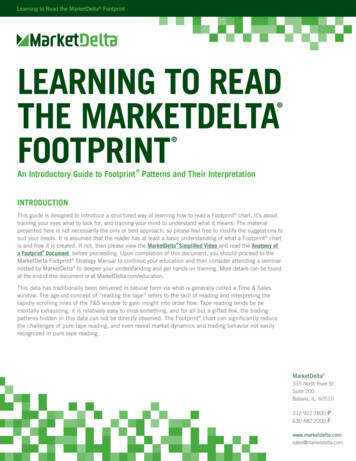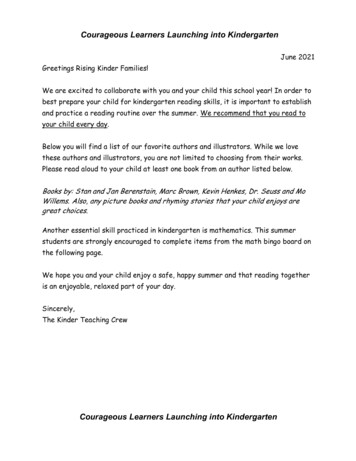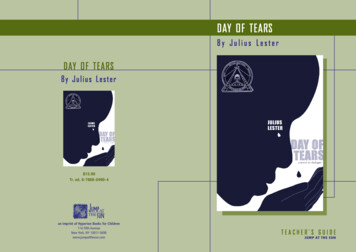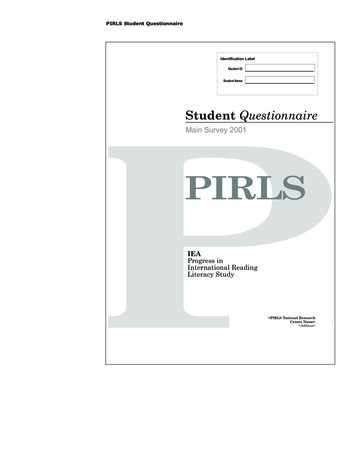
Transcription
Learning to Read the MarketDelta FootprintLearning to Readthe MarketDeltaFootprint An Introductory Guide to Footprint Patterns and Their InterpretationIntroductionThis guide is designed to introduce a structured way of learning how to read a Footprint chart. It’s abouttraining your eyes what to look for, and training your mind to understand what it means. The materialpresented here is not necessarily the only or best approach; so please feel free to modify the suggestions tosuit your needs. It is assumed that the reader has at least a basic understanding of what a Footprint chartis and how it is created. If not, then please view the MarketDelta Simplified Video and read the Anatomy ofa Footprint Document before proceeding. Upon completion of this document, you should proceed to theMarketDelta Footprint Strategy Manual to continue your education and then consider attending a seminarhosted by MarketDelta to deepen your understanding and get hands on training. More details can be foundat the end of this document or at MarketDelta.com/education.This data has traditionally been delivered in tabular form via what is generally called a Time & Saleswindow. The age-old concept of “reading the tape” refers to the skill of reading and interpreting therapidly scrolling lines of the T&S window to gain insight into order flow. Tape reading tends be bementally exhausting, it is relatively easy to miss something, and for all but a gifted few, the tradingpatterns hidden in this data can not be directly observed. The Footprint chart can significantly reducethe challenges of pure tape reading, and even reveal market dynamics and trading behavior not easilyrecognized in pure tape reading.MarketDelta 335 North River St.Suite 200Batavia, IL. 60510312 922 7800 P630 482 2000 Fwww.marketdelta.comsales@marketdelta.com
Learning to Read the MarketDelta Footprintorder flowIf the meaning of the phrase “order flow” is not clear to you, it should be by the end of this document.Order flow analysis is the missing link for many traders. It refers to how the orders are coming into themarket, how they are being filled; whether executing at the offer or on the bid. It is the dual auction atthe most micro-level. Assessing order flow in real time can tell the trader how trade is being facilitated inany direction, a key concept in auction market theory. The order flow patterns, as revealed by the Footprint chart, that we’ll be looking at are NOT traditional price patterns. Rather, these are T&S patternsthat you’ve probably never even realized existed. The T&S data simply moves too fast to comprehend,and then in a flash the data has scrolled by, out of site. The Footprint patterns can be classified intothree general categories: Intra-Bar Patterns, End of Bar Patterns, Multi-Bar PatternsThese patterns rarely, if ever, mean anything in and of themselves. This is where the MarketDeltaFootprint diverges radically from traditional price pattern and/or indicator based analysis. No attemptis made to oversimplify or under-simplify. Nor is the Footprint a red light / green light type “system”.Instead, the insight gleaned from a deep and experienced comprehension of the Footprint , allows thetrader to integrate this data along with current market context and sound market logic. For example,auction market theory or any other viable analytic philosophy which affords the trader the ability toassign structure and thus meaning to what he/she observes, combined with the Footprint , will providedecision support of the highest possible quality. The Footprint is not more or less important than eitherof the other two elements just mentioned; it is equal.In general, Market Profile , support and resistance analysis, trend lines, and other macro-type big pictureanalysis provides the WHERE TO TRADE. The Footprint excels in showing WHEN TO TRADE because of theway it represents order flow and volume.Always Keep In MindA Footprint is essentially a graphicalor spreadsheet-like rendition of themost basic and fundamental marketgenerated data which trading activityproduces. It is a very natural way toview the data.MarketDelta U.S 1.312.922.7800 U.K. 44.20.3287.9954 Asia / PacRim 61.2.8003.4996 support.marketdelta.comwww.marketdelta.com2
Learning to Read the MarketDelta FootprintAfter first gaining a basic understanding of what a Footprint chart is (which presumably you’ve alreadyachieved) the next step is to gain some level of observational awareness. Avoid making preconceivedconclusions. Avoid deciding, in advance, what something is going to mean. Instead, begin the processwith simply learning how to pick out key elements of Footprint structure. That’s what this document isall about. Once you have gained some facility with what the various elements of Footprint structure are,then you can begin coming to conclusions regarding the meaning of the elements in various contexts.Also, you can begin to assemble the elements into patterns. In this way, you’ll start making your ownrules, based on what is real, not what some tradition, some book, or some trading guru has told you;which may or may not be valid information. The Footprint lets you come to your own conclusions, if youlearn to see the Footprint in an unbiased fashion.Structural Elementsof the Footprint What Should You Be Watching For?As you learned in the Anatomy of a Footprint , there are many different variations of Footprints. Bidby Ask, Total Delta, Total Volume, etc. For learning purposes, we suggest sticking to the Bid by AskFootprint , and possibly the Footprint Profile.The Bid by Ask Footprint displays all the data, broken down into the finest resolution possible. Onlyafter you have experience with the Bid by Ask Footprint will you be able to make an informed choiceabout other ways to slice and dice the data which best fits your personal trading style. For now, we areonly focused on training your eyes what to see. Don’t trade while learning the Footprint . The act oftrading and the emotions involved can and usually does remove ones ability to clearly see what is, inan objective fashion. The added pressure of learning the Footprint while in a position or pondering anaction to enter or exit, will likely cloud what you’re seeing, such that you see what you want to see whichsupports your position and not what is actually there.Again, even if you end up preferring to work with a Footprint style other then bid/ask Footprint , it isrecommend starting out with the Bid by Ask Footprint for learning purposes, so you can see all the data.The other Footprint variants simply rearrange, filter, or alter how this basic data is displayed.MarketDelta U.S 1.312.922.7800 U.K. 44.20.3287.9954 Asia / PacRim 61.2.8003.4996 support.marketdelta.comwww.marketdelta.com3
Learning to Read the MarketDelta FootprintThe BUILDING Blocks ofFootprint Patterns The following sections will provide examples of some of the more important order flow patterns which theFootprint exhibits. The patterns can be broken down into three general categories:1. Intra-bar patterns: those patterns which form within and as a bar builds in real time.2. End of Bar patterns: those patterns which can only be assessed and analyzed at orafter the time which the bar closes.3. Multi-bar Patterns: which build over a series of bars.Looking at the finest resolution of how the patterns are built up, leads us to the three considerationsbelow. It is these considerations that form the building blocks (or elements as they will be referred to)upon which the larger patterns are composed, perceived, and analyzed by the trader. As you go throughthis document, and more so as you begin your learning and discovery process working with actualcharts, it is these three pattern types which you can lean on if you become stuck or confused. No matterwhere you find yourself in the process, you can ask yourself questions about these three pattern types.Questions about context, about relative and absolute changes between the elements within the pattern,and about how these three elements can create actionable patterns. Here are some of the key elementsto watch out for within the three pattern types.1. Intensity of volume and/or delta in a given Footprint bar or cell.2. The level of imbalance or balance between bid traded volume and offer tradedvolume in a given cell or cluster of cells.3. The ability or inability of price to continue in the direction of the current order flow,judged in the context of items #1 and #2 directly above.Intra-bar PatternsColors & Shades of Individual CellsThe darker the shade, the more imbalanced is the order flow. Lighter shades indicate a more balancedscenario. Likewise, a series of adjacent cells, all the same color, indicate directional trade. Roughlyalternating colors (candy-cane-like if you will) indicate balance and/or indecision. Don’t expect to see“perfect” patterns. You may find it easier to ask yourself what something doesn’t look like, rather thanwhat it does look like. This inverse way of thinking can sometimes release you from being too attached towhat you believe, instead of what’s really there.MarketDelta U.S 1.312.922.7800 U.K. 44.20.3287.9954 Asia / PacRim 61.2.8003.4996 support.marketdelta.comwww.marketdelta.com4
Learning to Read the MarketDelta FootprintRelative and Absolute Numeric ValuesRelative balance between bid volume and ask volume in each cell provides cluesabout trade facilitation and supply and demand. Roughly equal levels (within anorder of magnitude) of bid volume versus ask volume indicate balanced trade.Unequal amounts indicate directional trade. However, once the inequality reachesan extreme, this suggests a wall of demand or supply has been reached. For moredetail on understanding this phenomenon, see this article from the MarketDelta Blog: How to Spot Supply in MarketDelta .{When observing factors such as just described, keep in mind where price is andwhere it has come from – The overall context. For example: are you witnessingan extreme imbalanced cell AFTER a significant price move, or at the beginning?Does price currently reside at the boundaries of a long-term bracketing market,or is it dead in the middle of the range? The context will turn out to make all thedifference in the world.Note variations incolor and shade.Are the sequentialcells the samecolor?As price moves to new extremes (intra-day high or low, new daily high or low, etc),what is the bid/ask volume doing? The goal while observing the Footprint is todetermine whether trading activity is drying up, being facilitated, or increasing inpace at one form of price extreme or another.{The numeric values can have both relative meanings and absolute meanings.By relative, we mean how a particular value compares to its own value earlier inthe bar formation, and to adjacent cells and bars. Absolute numeric values willhelp with anticipating volatility. Each market will exhibit characteristic absolutevalues, as well as specific chart periodicities doing likewise. All this really means isdepending on the market being followed and periodicity being viewed the numericvalues shown on the Footprint will vary. Time of day, special events (pre-holidaytrade, quad-witching day, news events, etc) should be considered when evaluatingabsolute volume levels.Or, do they vary,with only 2 or 3cells in a row thesame color?ModeratelyImbalancedExtremeImbalancedDry Up of ActivityMarketDelta U.S 1.312.922.7800 U.K. 44.20.3287.9954 Asia / PacRim 61.2.8003.4996 support.marketdelta.comwww.marketdelta.com5
Learning to Read the MarketDelta FootprintEnd Of Bar PatternsVolume nodes and High Volume pointsA volume node is simply a price level with a pronounced “bump” in the totalvolume traded at that price. A given bar (or period of time) will have associatedwith it a high volume node (the highest volume traded price) but there will alsobe minor volume nodes, which can and often are significant. The nodes should betracked and price behaviour noted upon revisiting these nodes. When assessing aFootprint , ask yourself which end of the bar held the bulk of the traded volume.Was it nearer the open of the bar or nearer the close? Or, was the entire bar moreor less distributed evenly? Perhaps the trade is distributed in a bell-curve shapedistribution, suggesting a very balanced market, at least in the moment. Again,context is vital. Is the volume so high in the node that it suggests bumping intosupply or demand? Is there a distinct node, but the overall volume of the bar is solow as to render the volume node meaningless?Bulk of volumelocated nearerclose of bar,suggestingcontinuedmovement in thatdirection or atleast a pause; nota reversal.Markets in micro-balance can mean different things at different times. It is thetrader’s job to understand the context: is balance being caused by typical lunchtime inactivity or is the balance being caused by a consensus of value among allthe participants? Is this part of a larger balance? Or a pause in a strong trend? Isthe balance the result of reasonably wide trading rotations, or the result of little orno market activity?This is a relativelybalancedFootprint . Notethat the bar opensand closes nearthe same point,exactly what youwould expect inbalance.Another variation on volume node at bar extreme is shown in the graphic isshown in the graphic on the top right of the next page. Note the similarity ofthe distribution of volume to the first example in this section. The total volumedistribution is similar. However, the first example (above right) showed a volumenode low in the bar, and was shown as selling volume. In the case shown below,we again have a volume node low in the bar, but this time with significant buyingvolume indicated. There is a battle going on, not just a pause. Is this a reversal?One can’t say for sure. It’s far from certain what this means, but this sort ofinformation still can help. Having information which suggests uncertainty in themarket is still useful. You might use such a signal of uncertainty to take profits orto get out of a trade altogether.MarketDelta U.S 1.312.922.7800 U.K. 44.20.3287.9954 Asia / PacRim 61.2.8003.4996Here is the samebar, shown inprofile form.Clearly, somepatterns aremore apparentgraphically, whileothers are moreclear numerically. support.marketdelta.comwww.marketdelta.com6
Learning to Read the MarketDelta FootprintNon-zero prints at bar extremesHigh volumenode, the bottomof a down bar, isshowing buying;not what you wantto see if you areshort.The fact that buying or selling does not completely “shut off” or “dry up” at theextreme of a bar (an auction theory concept) suggests that business at that pricelevel is not yet complete, at least in the very short term time-frame. A retest ofsuch a level is highly probable because trade can still be facilitated at that price.Bar TotalsDo not forget traditional data like total volume and price range. The Footprint doesn’t replace basic price/volume relationship analysis, it supplements it. Butnow, in addition to total volume for a given period (or bar) the trader can look attotal delta, which is essentially showing the net order flow conviction. It can beuseful to compare these values (price range, volume, and delta); both from bar tobar, and also to note how volume and delta for the bar are correlated. In order tomake it easier on the trader, MarketDelta has a built-in function which displaysthese bar totals for you. It’s called the Footprint Bar Statistics indicator and isshown below. The Footprint Bar Statistics panel can also show numerous otherdata values for each bar and is fully user adjustable.At bar extremes,when neither thebid side or askside is zero, thereis a high degreeof probability thatthis price will beretested.The upper rowis total volume,the lower row isdelta, which isthe net differencebetween volumetraded on the bidand the offer.MarketDelta U.S 1.312.922.7800 U.K. 44.20.3287.9954 Asia / PacRim 61.2.8003.4996 support.marketdelta.comwww.marketdelta.com7
Learning to Read the MarketDelta FootprintMulti-bar PatternsFailed AuctionFailures can take many forms. Buyers or sellers may not be active at a particular price level. Neitherside may be interested at current prices. Learn to differentiate between a true failure and somethingthat appears like a failure. For example, compare a market which has moved up on strong volume to akey point of resistance immediately after the open and then volume at the extreme prices drops off toa mere crawl; versus a market with no news, moving into lunch time, and just not much going on, alsoshowing very weak volume at a relative price extreme. In the first case, there is potential for a trade, inthe second case, most traders would be wise to simply stand aside as the potential reward, given therisk, just isn’t present.In the example below, we see a combination of volume first dropping off as price makes little upwardheadway, and then one last round of buying (the dark green price cell) with no ability to move price up.This example begins to show how the analytic puzzle pieces start coming together. First, we take noteof successively higher prices (bar by bar) ending with failed auctions at the top of each bar. Then, theorder flow shows relatively strong buying in the form of a dark green Footprint cell and a significantlyimbalanced cell at that (89 sells versus 1,022 buys). Yet, the best price can do is move up 1 tick fromthe heavy buying and immediately dries up. Next thing you know, that strong buying turns into strongselling, in the adjacent two price cells below. This is how you read the Footprint . If this arrangementoccurred at a price level of significance (i.e. a previous day high, edge of multi-day range, upperboundary of a value area, etc), then this scenario would represent an ideal potential trade entry.We urge you, though, not to simply go looking for patterns that exactly mimic this scenario. That’s notwhat this is about. It is about assessing how all the pieces fit together for a given context.Note the seriesof Footprint top cells, eachshowing ZEROselling, yetbuying is at avery low level,and continues todecrease.Buying comes in,but cannot budgeprice.MarketDelta U.S 1.312.922.7800 U.K. 44.20.3287.9954 Asia / PacRim 61.2.8003.4996 support.marketdelta.comwww.marketdelta.com8
Learning to Read the MarketDelta FootprintHow is the POC/high volume node movingDetermining whether or not trade is being facilitated at a given time or a given price level is avital component of real time analysis. Trade facilitation is part of the answer to the question:what is the context? It is equally important to understand in which direction trade is beingfacilitated and which it isn’t. This is simply another way of looking at order flow characteristics.Merely looking at price bars (i.e. no Footprint ) will not provide the whole story, much less anaccurate story. However, if the trader tracks the directional movement of the high volume node,this will provide a more accurate picture of the true trend direction of the market. In a given timeframe. In the sequence of bars displayed below, the Volume Price Statistic indicator (the bluedots), another function unique to MarketDelta, has been added to the Footprint . This tooleliminates the need for the trader to mentally calculate the high volume prices. With the VPSindicator, they can be easily seen at a glance.The blue dotsshow the pricelevel with thehighest tradedvolume, otherwiseknown as thepoint of control.Price made ahigher (bar bybar) high.Yet the total deltafor the bar wasnegative.Divergences between Price and Total Delta“Delta Divergences” can take many forms, but ultimately they show only one thing: the convictionsof traders’ choices do NOT match price movement. There is behavioral incongruence. Essentially, fora given price movement, there is a lack of aggressiveness which is normally needed (and associatedwith) to support continued price movement in a particular direction. In addition to the bar-by-bar typedivergence shown above, divergences can occur over a sequence of an arbitrary number of bars.MarketDelta U.S 1.312.922.7800 U.K. 44.20.3287.9954 Asia / PacRim 61.2.8003.4996 support.marketdelta.comwww.marketdelta.com9
Learning to Read the MarketDelta FootprintUsing the Footprint ProfileTrend bar downexample fromsection on VolumeNodes, not easy topick out the highvolume buying athe high volumenode.As you now know, there are numerous variants of the basic Bid by Ask Footprint .However, there are two fundamentally different types of Footprint which youshould be aware of. Each does a better job displaying certain aspects of the orderflow. First, there is the type with actual numeric values (as used thus far in thisdocument). The second type places a focus on a graphical representation of theFootprint . This is known as the Footprint Profile, and itself comes in severalvariants. This was introduced in the Footprint Profile above, in the sectionon volume nodes. There are pro’s and con’s to each type, so it is generally aworthwhile endeavor to experiment with both. Some traders will have a clearpreference between the two, others will prefer to make use of both.The Footprint Profile is particularly useful for making rapid, broad distinctions,where as the Bid/Ask Footprint , provides the most detail.At the beginning of the Footprint learning curve, you might find it helpful to havetwo Footprint s open, both identical EXCEPT for the Footprint type. Set one toBid by Ask, the other to Footprint Profile. Seek out an understanding of how thevarious numeric patterns appear in profile format, and vice versa. Looking at thesame data through different lens’ allows a perspective that can not be afforded inany other way.Suggested Selfteaching exercisesIn profile format,it’s very easyto see and seequickly.Many of the best traders approach the learning process and refinement of skillsin a similar way to what professional athletes do. Slow things down, speed thingsup, lots and lots of review. Tons of practice. Below are some suggested exerciseswhich are designed to improve the accuracy and speed with which you are ableto assimilate the data being presented in the Footprint . Do not let the simplicityof these exercises fool you. They are designed to both train your mind to noticeimportant patterns, and do so with greater and greater speed. It’s not a bad idea torevisit these exercises from time to time, further enhancing your skill level. Doingthese exercises with Playback at both accelerated and reduced speeds will trainyour mind to notice patterns more quickly and confidently. Finally, when performinga drill for an extended period of time, every so often switch over to a different drillor even a live market for brief stints. Mixing and matching the exercises and drillswill afford a learning environment that can more easily be translated into realworld, practical, skill improvement.MarketDelta U.S 1.312.922.7800 U.K. 44.20.3287.9954 Asia / PacRim 61.2.8003.4996 support.marketdelta.comwww.marketdelta.com10
Learning to Read the MarketDelta Footprint Print out several copies of each of a number of days Footprint s in your choice of periodicity. Pickone of the Footprint patterns or elements described in this document and circle every instance youcan find. Go back later and see if you missed anything. Then, take another printout of the same day,and repeat the exercise for a different pattern or element. Repeat for each element or pattern youchoose to. Choose a particular range of time and examine it on several different periodicities. For example, 5 min,15 min, 1.0 range, 5000 volume and 610 tick. Make sure you choose several periodicities which arenon-time based. Compare these charts to see how the Footprint elements and patterns can be similarand how they can be different merely by changing periodicity. The markets are fractal in nature. Thisexercise provides some insight to seeing inside the fractal dimension of market data. Using playback charts, choose a pattern to watch for. Then, repeat the playback at gradually increasingspeeds. This will instill the pattern in your unconscious and make it seem as though the real marketis almost in slow motion, thus affording you additional decision making time with real trading, via thephenomenon of time distortion. During a live market, record in a journal the elements and patterns as you see them form, along withother related observations. After the close, go back and review what you recorded versus what actuallyhappened. Did you observe and record accurately? Did you miss anything. Did you discover anything?Doing these sort of exercises is how any sort of skill is initially developed. It’s how the best athletesimprove, and it’s how great traders improve. Use drills as an opportunity to focus on learning one aspectwell, then move on to the next. Don’t try and learn it all at once.The above discussion and suggested drills can be described as explicit learning. You, the trader, isprovided with specific information and practice techniques. You know what you’re doing and what thepurpose of the drills are at any moment. However, there is another type of learning known as implicitlearning. In trading, implicit learning is essentially the process of unconscious pattern recognitiondevelopment. This can only occur through extensive time in front of the screen viewing live marketsand reviewing played back data. We would be the first to admit that we used to cringe when we weretold “it takes screen time”. We didn’t want to hear about screen time. We wanted to be given a set ofinstructions, make trading black and white, and then just do it. We felt this way because we didn’t haveany confidence in this unconscious learning being real. We didn’t have confidence that we were actuallylearning anything via practice drills and simulated trading. It didn’t feel like screen time was producingany benefit. Well, it turns out that this implicit type of learning does actually occur. Wef would stronglyrecommend anyone serious about developing their own training regimen and desiring more details onhow implicit learning plays a role in trading success, to obtain Dr. Brett Steenbarger’s books on tradingpsychology. They are an invaluable resource.MarketDelta U.S 1.312.922.7800 U.K. 44.20.3287.9954 Asia / PacRim 61.2.8003.4996 support.marketdelta.comwww.marketdelta.com11
Learning to Read the MarketDelta FootprintUse What YouAlready Know:Learning the Footprint doesn’t mean having to give up what you’ve alreadylearned, what you’ve already discovered to be useful. With the MarketDeltaFootprint , it’s possible to superimpose indicators on the Footprint if you haveconfidence in indicator signals. If you already watch volume using a standardhistogram, don’t stop watching that. Instead, use what you know about the volumehistogram and see what that looks like in the Footprint . Are you partial to basicprice action: higher highs, higher lows, etc? Well, use that. And start looking athow the Footprint can reveal subtle differences between what happens at higherlows in an uptrend versus a higher low (a potential reversal) in a down trend.Whatever you currently do that seems to make sense and/or affords some level ofsuccess, see if you can’t figure out a way to combine that with what theFootprint reveals.A word of caution though: watch out for making the mistake of informationoverload. Don’t add everything together at once. Don’t pile on so many indicatorsthat your screen looks like spaghetti. Take your time. See how the variousanalytical tools you have at your disposal fit together like a puzzle. A scientificapproach, where you change one aspect at a time, and learn what that can tellyou or does, is probably the best way to go about this discovery process. Anotherprofoundly powerful suggestion from the field of learning theory is to focus onjust a single pattern. Master it. Make it your own. Once you do this, something ofa miracle occurs: mastery of one particular pattern seems to carry over in such away that you suddenly seem to know about lots of other patterns too. The key toobtaining this learning leverage is to really focus on just a single pattern.If you use pure price action, like thishigher low, compare the Footprint elements and patterns of higher lowswhich continue up, versus those thatfail and continue down. There will oftenbe clues which simply can’t be seenwithout the Footprint .If you use an ocsillator (such as thestochastic shown here) crossing oversome reference level, compare theFootprint elements and patterns ofscenarios which show price followthrough against those which do notfollow through.MarketDelta U.S 1.312.922.7800 U.K. 44.20.3287.9954If you use trend lines: compareFootprints of trend line break out barswhich fail against those which followthrough. Look at all the Footprintelements and patterns described in thisdocument and how they vary betweensuccessful and unsuccessful breakouts. Asia / PacRim 61.2.8003.4996 support.marketdelta.comwww.marketdelta.com12
Learning to Read the MarketDelta FootprintWhat the FootprintReally Means: If the purpose behind the Footprint had to be distilled down to a single sentence, it would be to answerthis question: Do the buyers or the sellers, right now, exhibit more conviction. The Footprint expressesthis conviction, via the patterns described in this document and the raw data itself as displayed eithernumerically or graphically. The pace or rate of trade, comparative levels of buy and sell volume, andstatistically significant shifts in the order flow (eg. how much did delta reverse or shift?) all provideevidence of either supply, demand, or indecision. Understanding the conviction of the order flow isnot something which any indicator or price alone can provide. The Footprint affords a
Footprint , and possibly the Footprint Profile. The Bid by Ask Footprint displays all the data, broken down into the finest resolution possible. Only after you have experience with the Bid by Ask Footprint will you be able to make an informed choice about other ways to slice and dice the data which best fits your personal trading style.







![How to choose a broker [EN] - Forex Tester](/img/51/how-to-choose-a-broker.jpg)


